It’s been a couple of weeks since my return from The Rye Baker Baltic Rye Tour 2018 – enough time for the impressions and memories to mellow and integrate and for me to gain some perspective on a whirlwind of sights, sounds, tastes and human interactions. In all, we were 18; most of us dedicated bread nerds, both professionals and home bakers, united in our desire to experience rye on its home turf and hungry to expand our knowledge of the unruly grain.
To say the tour was a success would be an understatement; it was a home run, although not quite a grand-slam. Inevitably, there were some scheduling glitches, such as sitting down to two super-bountiful Latgalian feasts (Latvian white lightning included) within 3 hours of each other, and a two-hour spa/sauna session that didn’t happen because we spent more time at a bakery than planned.
I think that Larry Lowary, one of our hardy and widely-traveled companions, spoke for the group when he wrote, “I’ll add my thanks (and appreciation) to all of you for a wonderful, wonderful trip. I’ve never taken a group tour and despite my occasional (likely unwarranted) grumblings, found it great. I’ve met an amazing group of men and women interested in so many things.”
The tour went so well, in fact, that I’m gonna do it again next year.
Here’s a snapshot of what we saw, experienced and tasted:
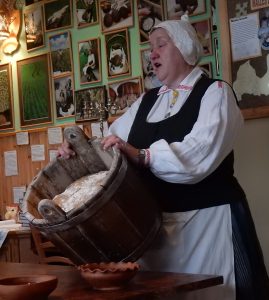
In the countries surrounding the Baltic Sea, rye bread is more than the mainstay of traditional Nordic and Baltic diets; it’s a divine gift and a source of national identity. Rye bread, Finnish Bakers Association Executive Director Mika Väyrynin told us, has official standing as Finland’s national food. In Latvia, Aglona Bread Museum director Vija Kudiņa described rye bread’s iconic status. “Bread,” she said, “is a blessing from God: if it falls on the floor, we pick it up and kiss it; if one turns a loaf upside down, bad luck will surely follow.” And so we ate, with appreciation and reverence.
 Our itinerary took us not just to the usual tourist sites – the skeletons of medieval castles at Raseborg and Turaida, the natural splendors of Västerby and Gauja Nature Preserve, the baroque grandeur of Rundāle Palace and the cultural and gustatory delights of Helsinki and Riga – but also to farms, mills and bakeries where we experienced firsthand the methods, techniques and mindsets that make Finnish and Latvian rye breads among the best in the world.
Our itinerary took us not just to the usual tourist sites – the skeletons of medieval castles at Raseborg and Turaida, the natural splendors of Västerby and Gauja Nature Preserve, the baroque grandeur of Rundāle Palace and the cultural and gustatory delights of Helsinki and Riga – but also to farms, mills and bakeries where we experienced firsthand the methods, techniques and mindsets that make Finnish and Latvian rye breads among the best in the world.
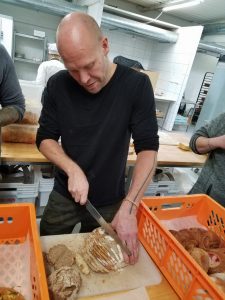 In Helsinki, Teemu Aura and Markus Huskainen, founder-owners of Patisserie Teemu & Markus, welcomed us into their commissary for a tour and a sampling of pulla – traditional Finnish sweet rolls – and korvapuusti – Finland’s unique take on cinnamon buns. For me, the highlight was their riihiruisleipä , the intensely flavored bread built on smoked rye flour that’s fire-dried during the long, dark Finnish winters.
In Helsinki, Teemu Aura and Markus Huskainen, founder-owners of Patisserie Teemu & Markus, welcomed us into their commissary for a tour and a sampling of pulla – traditional Finnish sweet rolls – and korvapuusti – Finland’s unique take on cinnamon buns. For me, the highlight was their riihiruisleipä , the intensely flavored bread built on smoked rye flour that’s fire-dried during the long, dark Finnish winters.
Where Helsinki is dominated by its proximity to the Baltic Sea, rural Finland reveals a different character. On our way west, we drove through miles and miles of mixed birch and conifer forest, punctuated now and then by modest cottages, small businesses and an endless progression of “Moose Crossing” signs.
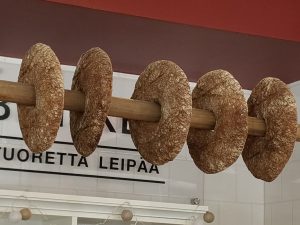 In Bollstad, on Finland’s southwestern coast (the Archipelago), Olle Lindholm of Backers Baker AB put us to work making hapanleipää, the familiar doughnut-shaped flat loaves that are stored on poles hung from the ceiling. In Raseborg, Niklas Näsman, head baker and grandson of the founder of Wi-Box Bageri, let us sample his malla leipää (malt rye), which he bakes twice – the second time wrapped in paper-lined aluminum foil. In Tammisaari, Anna Alm, 10th generation owner of Mörby Gård, an organic farm that’s been in operation since the 1300s, took us into her fields to show us at firsthand her rye, wheat and cattle operation. A bag of her rye flour came back home with me.
In Bollstad, on Finland’s southwestern coast (the Archipelago), Olle Lindholm of Backers Baker AB put us to work making hapanleipää, the familiar doughnut-shaped flat loaves that are stored on poles hung from the ceiling. In Raseborg, Niklas Näsman, head baker and grandson of the founder of Wi-Box Bageri, let us sample his malla leipää (malt rye), which he bakes twice – the second time wrapped in paper-lined aluminum foil. In Tammisaari, Anna Alm, 10th generation owner of Mörby Gård, an organic farm that’s been in operation since the 1300s, took us into her fields to show us at firsthand her rye, wheat and cattle operation. A bag of her rye flour came back home with me.
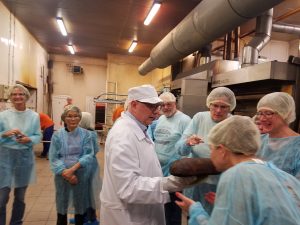 In Latvia, new experiences piled one on top of the other, in a flood that stimulated my senses to the point of near-overload. At Lāči (lah-chee) Bakery, in Liepāja, founder-owner Normunds Skauģis gave us the grand tour, then set a wooden tub of bulk-fermented saldskāba (sweet-sour) dough in front of us, inviting each of us to shape our own loaves, just like the production workers nearby. Unlike other bakeries, Lāči breads immediately go into an 800°F wood-fired oven, where they bake for 15 seconds in to set the crust, and then get transferred to another oven to bake off for an hour at 350°F. After lunch at the Lāči cafe, our loaves were delivered to us, glazed with a solution of potato starch and shrink-wrapped for the trip back home.
In Latvia, new experiences piled one on top of the other, in a flood that stimulated my senses to the point of near-overload. At Lāči (lah-chee) Bakery, in Liepāja, founder-owner Normunds Skauģis gave us the grand tour, then set a wooden tub of bulk-fermented saldskāba (sweet-sour) dough in front of us, inviting each of us to shape our own loaves, just like the production workers nearby. Unlike other bakeries, Lāči breads immediately go into an 800°F wood-fired oven, where they bake for 15 seconds in to set the crust, and then get transferred to another oven to bake off for an hour at 350°F. After lunch at the Lāči cafe, our loaves were delivered to us, glazed with a solution of potato starch and shrink-wrapped for the trip back home.
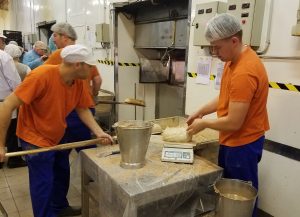 In Limbaži, Valters Kanopa, head baker at Lielezers, took us through the bakery, which uses a five-zone gas-fired tunnel oven for its rye breads, and introduced us to some rye cookies and pastries he’s developing for the market.
In Limbaži, Valters Kanopa, head baker at Lielezers, took us through the bakery, which uses a five-zone gas-fired tunnel oven for its rye breads, and introduced us to some rye cookies and pastries he’s developing for the market.
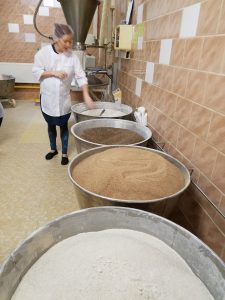 In Ranka, Juris Paulovičs greeted us at Ķelmēni (pronounced chyel-mah-nee) farm, which he bought in 1991. In 1997, when the rye market collapsed, his wife suggested that instead of letting his grain rot, they build a bakery. Juris, his daughter Rūta and son-in-law Raitis conducted us through the bakery, answering questions and showing us every aspect of their operation before inviting us to their home for coffee and bread. Today, Juris and his children grow, mill and bake their own grain into what many Latvians consider to be their country’s finest breads, bulging bags of which were given to each of us as we left the farm.
In Ranka, Juris Paulovičs greeted us at Ķelmēni (pronounced chyel-mah-nee) farm, which he bought in 1991. In 1997, when the rye market collapsed, his wife suggested that instead of letting his grain rot, they build a bakery. Juris, his daughter Rūta and son-in-law Raitis conducted us through the bakery, answering questions and showing us every aspect of their operation before inviting us to their home for coffee and bread. Today, Juris and his children grow, mill and bake their own grain into what many Latvians consider to be their country’s finest breads, bulging bags of which were given to each of us as we left the farm.
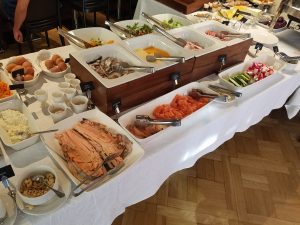 Rye bread of extraordinary quality was everywhere. At our hotel breakfasts – themselves offering mind-boggling assortments of local cheeses, smoked meats and fish, eggs, vegetables, cereals, pastries and almost anything else imaginable – intensely flavorful rye bread of consistently high quality was a featured player. At lunch and dinner, more of same. At Folkklubs Ala, a cellar cabaret in Riga’s Old Town, garlic rye sticks were the preferred beer snack. In the restaurants and guesthouses where we ate, rye bread was incorporated into a variety of desserts, from parfaits (see below) to cheesecake.
Rye bread of extraordinary quality was everywhere. At our hotel breakfasts – themselves offering mind-boggling assortments of local cheeses, smoked meats and fish, eggs, vegetables, cereals, pastries and almost anything else imaginable – intensely flavorful rye bread of consistently high quality was a featured player. At lunch and dinner, more of same. At Folkklubs Ala, a cellar cabaret in Riga’s Old Town, garlic rye sticks were the preferred beer snack. In the restaurants and guesthouses where we ate, rye bread was incorporated into a variety of desserts, from parfaits (see below) to cheesecake.
 Wherever we went, the breads reflected local tastes and regional cultures. In Helsinki, they were satisfyingly sour and nutty; on the Archipelago, where the culture has a strong Swedish flavor, the breads were sweet and often contained dried berries – and, at Svartå Manor’s superb restaurant, a sprinkling of chili flakes (!!!). In Latvia, the breads were dense and sweet-sour, with hints of caraway and anise. Some held minute orange flakes of shredded carrot; others were dark, moist and rustic, with flavors assertive enough to complement the cured meats and cheeses typical of the Latvian diet.
Wherever we went, the breads reflected local tastes and regional cultures. In Helsinki, they were satisfyingly sour and nutty; on the Archipelago, where the culture has a strong Swedish flavor, the breads were sweet and often contained dried berries – and, at Svartå Manor’s superb restaurant, a sprinkling of chili flakes (!!!). In Latvia, the breads were dense and sweet-sour, with hints of caraway and anise. Some held minute orange flakes of shredded carrot; others were dark, moist and rustic, with flavors assertive enough to complement the cured meats and cheeses typical of the Latvian diet.
For a rye lover like me, our journey was 12 days of heaven – and more, if you count the 5 kilos of bread I brought back with me (plus several kilos of rye flour) and continue to feast on.
One of my favorite rye dishes was this traditional Latvian dessert, rūpjmaizes kārtojums, a parfait of sweetened rye bread, berry preserves and whipped cream – a simple yet elegant complement to its largely meat-and-potatoes cuisine.
To make it, soak 2-3 cups of stale rye crumbs in a mixture of 1/2 cup/115 ml each of simple syrup and rum for at least an hour. (For a nonalcoholic alternative, use 1/2 cup of water plus 1 Tbs of rum flavoring). In a glass, alternate layers of the soaked rye, berry preserves (I prefer lingonberry) and sweetened whipped cream. Easy and oh, so good!

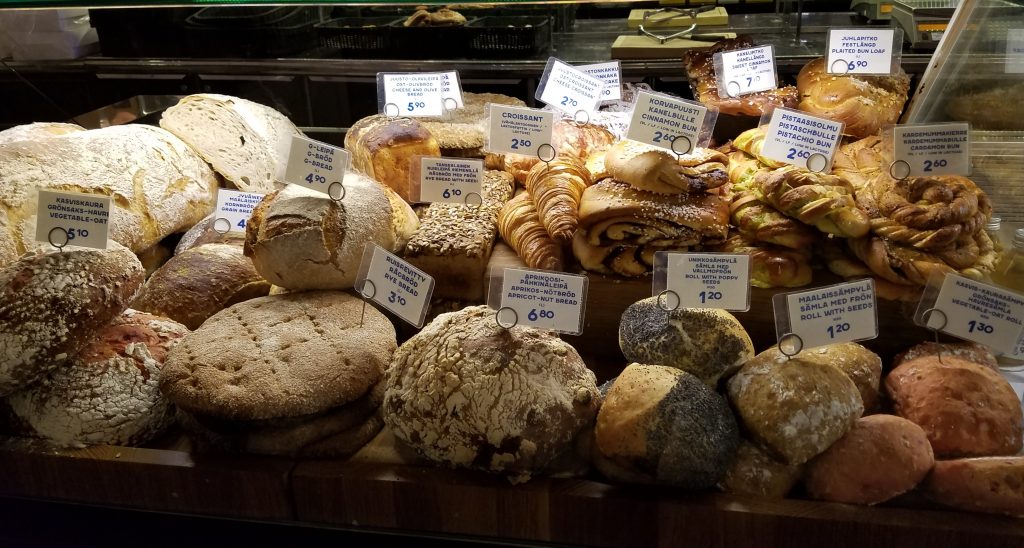

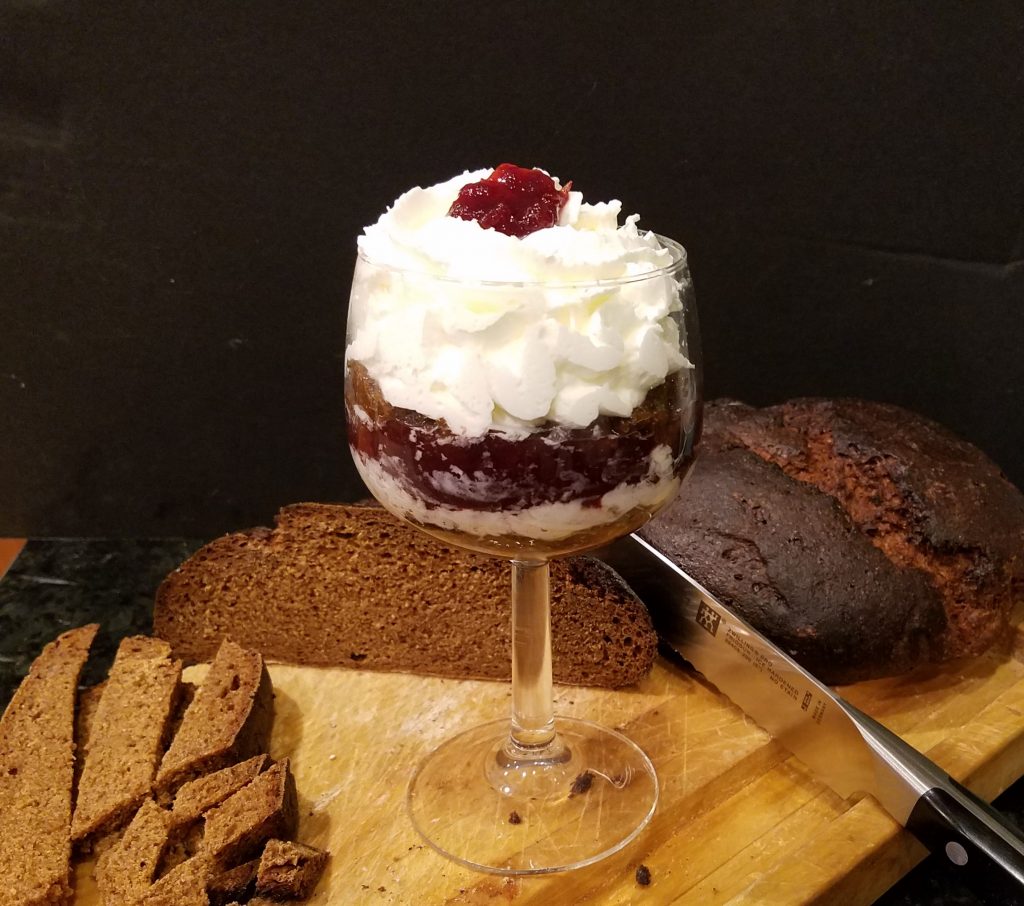
Karin Anderson
October 20, 2018Sounds like a very nice and interesting trip!
Funny, the berry dessert you describe is my family’s favorite dessert, called “Pommersche Götterspeise” (Pommeranian Ambrosia) in Stettin (now Sczecin), where my mother came from. The Pommeranian version is made with (fresh) pumpernickel crumbs, mixed with grated chocolate, layered with whipped cream and lingonberry preserve.
Larry Lowary
October 20, 2018To say The Rye Baker’s Baltic tour was wonderful is an understatement. Each of the 12 days was filled with unexpected glimpses of life (and the food) of Finland and Latvia. If all any of this appeals to you, by all means, ask questions NOW and be prepared to sign up once details of the 2019 trip are released. I’m betting it will be a sellout with a long waiting list. Not mentioned, but perhaps the best part of the tour, were the local guides who patiently answered hundreds of questions (about their countries and their breads). Henrica and Eva (and drivers Dennis and Helmuts) offered us glimpses of two amazing, yet not-often-considered, Baltic countries. Thanks Stan….you did good!
Sabine FriedrichWalter
October 20, 2018already homesick!
Paul Bana
October 21, 2018What a great way to experiece rye breads! I’m headin there (from Australia to the Baltics) next May.
You say you are going to do it again? If I may suggest – https://m.facebook.com/Mik%C4%97n%C5%B3-kaimo-vyr%C5%B3-duona-119369231444255/
Danielle
October 21, 2018Sounds so amazing! Would love to go on the next one!
Joe Silberlicht
October 21, 2018…and don’t forget the lovely rye bread cordial we enjoyed on the bus, courtesy of Eva!
Stanley Ginsberg
October 21, 2018how right you are … two exceptional rye distillates — a sweet, plummy cordial and Latvia’s version of classic rye whiskey. Plus šmakovka. that great Latgalian white rotgut that got me so messed up at Andrupene farm!
Mike Avery
October 21, 2018I was SO on the fence about signing up for the tour and now regret not having done so.
It sounds like I missed out on a great experience!
Frank Martinez
October 21, 2018What a wonderful trip this was. It’s amazing how a few simple ingredients can bring a lifetime of joy. Is there any recipes that you can share so I can make them at home. I hope to join you on one of these trips in the future. Thank you for sharing.
Inese Grava-Gubins
October 21, 2018So happy you all enjoyed this trip! I can shut my eyes, and still smell the wonderful rye bread in Latvia. Have not been to Finland’s bakeries – hopefully I can join you on a future trip.
One of the things that blows my mind in Latvia involves walking into any grocery store, and seeing an entire wall (or more) of rye bread….and I am in awe, and cannot decide which kind to try first….and I so miss those choices here in N America. Then the garlic toasts served in most every restaurant…yum! The rupjmaizes kartojums can also be made without soaking the rye bread crumbs in rum, or water+rum, but instead you can just mix the crumbs with a bit of cinnamon and sugar, and then layer them with plenty of lingonberry preserves (hint – head to Ikea stores to get jars of very decent lingonberry jam in N America), and layers of whipped cream. If you let these layers sit a while, the crumbs soak up the moisture from both the jam and the whipped cream. You can also flavor the whipped cream if desired, or add a bit of powdered sugar to the whipped cream. This dessert tastes best when it has been assembled, layered, a few hours before it is served.
Mark Matuseski
October 22, 2018Where do I sign up?
Stanley Ginsberg
October 22, 2018Watch this space!
Julia
October 23, 2018Mr. Ginsberg,
My friend Esther and I went to Asheville, NC to take your Rye Bread making class in May of this year. It lasted for 3 hours, but we did not want it to end. Let us know about your next trip now so we can save up. We would love to attend.
Stanley Ginsberg
October 23, 2018Watch this space!
Sonja Burchard
October 27, 2018To this rye lover the tour does sound like absolute heaven! Unfortunately, as a baker working on opening a bakery, I wasn’t able to afford the trip. To satisfy my cravings I will do my best to produce and introduce as many rye breads as possible to my future customers…
Stanley, your pioneering blog and book have been instrumental in giving me the belief to take these next steps in following my passion for rye. Thank you!
Stanley Ginsberg
October 27, 2018You’re welcome, Sonja! I hope your customers are as passionate as you are. May you have much success!!
Helen
October 28, 2018I would love to tour with you please. I am from the UK ❤
Gretchen Kopmanis
October 29, 2018If you’re making these breads and find yourself asking questions, this trip will validate you!
Gretchen Kopmanis
October 29, 2018For me, this trip was enormously validating! I’ve had so many questions about the nature of these high-percent rye recipes, and I was pretty much spot-on with my observations. The behind-the-scenes stuff was simply amazing! The starters made in aspen barrels (slightly larger than a 5-gallon bucket, but dozens and dozens of them!) The bread proofing in large wooden bins. The ‘master baker’ skilled in removing the dough without damaging the internal structure. The sweet-sour starters that taste like applesauce. The dough so wet and sticky it feels more like potters clay than bread dough. I would have loved to see the birth of the bread: from mixing the sour, to it’s time proofing, to mixing and making the dough, shaping, proofing again, baking, resting, bagging… and clean up! I can’t help but wonder how you clean out the wooden trenchers where the dough proofed? Cleaning the aspen barrels? Even more behind the behind-the-scenes of rudzu maize (rye bread). I don’t often lament a trip once it’s over, but I find myself already wanting to go back. Great job, Stan! Thank you for this fabulous experience.
Stanley Ginsberg
October 29, 2018It was an amazing experience … with an equally amazing group of people! Thank you and Jeff for your energy and continuing contributions to the tour and our group. S
Kelli m Hyatt
November 1, 2018Looks like a lot of fun. I wish I had something like this going on where I live.
Stanley Ginsberg
November 2, 2018Where do you live and what do you mean by “something like this?”
Susan
November 23, 2018I would love to join up for the next trip!